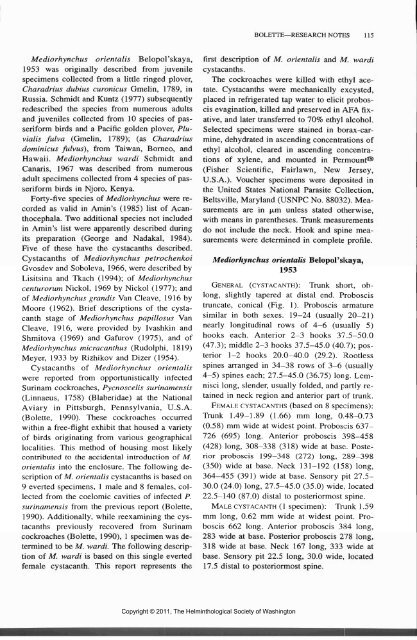Comparative Parasitology 67(1) 2000 - Peru State College
Comparative Parasitology 67(1) 2000 - Peru State College
Comparative Parasitology 67(1) 2000 - Peru State College
You also want an ePaper? Increase the reach of your titles
YUMPU automatically turns print PDFs into web optimized ePapers that Google loves.
Mediorhynchus orientalis Belopol'skaya,<br />
1953 was originally described from juvenile<br />
specimens collected from a little ringed plover,<br />
Charadrius duhius curonicm Gmelin, 1789, in<br />
Russia. Schmidt and Kuntz (1977) subsequently<br />
redescribed the species from numerous adults<br />
and juveniles collected from 10 species of passeriform<br />
birds and a Pacific golden plover, Pluvialis<br />
fulva (Gmelin, 1789); (as Charadrius<br />
dominions fulvus), from Taiwan, Borneo, and<br />
Hawaii. Mediorhynchus wardi Schmidt and<br />
Canaris, 19<strong>67</strong> was described from numerous<br />
adult specimens collected from 4 species of passeriform<br />
birds in Njoro, Kenya.<br />
Forty-five species of Mediorhynchus were recorded<br />
as valid in Amin's (1985) list of Acanthocephala.<br />
Two additional species not included<br />
in Amin's list were apparently described during<br />
its preparation (George and Nadakal, 1984).<br />
Five of these have the cystacanths described.<br />
Cystacanths of Mediorhynchus petrochenkoi<br />
Gvosdev and Soboleva, 1966, were described by<br />
Lisitsina and Tkach (1994); of Mediorhynchus<br />
centurorum Nickol, 1969 by Nickol (1977); and<br />
of Mediorhynchus grandis Van Cleave, 1916 by<br />
Moore (1962). Brief descriptions of the cystacanth<br />
stage of Mediorhynchus papillosus Van<br />
Cleave, 1916, were provided by Ivashkin and<br />
Shmitova (1969) and Gafurov (1975), and of<br />
Mediorhynchus micracanthus (Rudolphi, 1819)<br />
Meyer, 1933 by Rizhikov and Dizer (1954).<br />
Cystacanths of Mediorhynchus orientalis<br />
were reported from opportunistically infected<br />
Surinam cockroaches, Pycnoscelis surinamensis<br />
(Linnaeus, 1758) (Blaberidae) at the National<br />
Aviary in Pittsburgh, Pennsylvania, U.S.A.<br />
(Bolette, 1990). These cockroaches occurred<br />
within a free-flight exhibit that housed a variety<br />
of birds originating from various geographical<br />
localities. This method of housing most likely<br />
contributed to the accidental introduction of M.<br />
orientalis into the enclosure. The following description<br />
of M. orientalis cystacanths is based on<br />
9 everted specimens, 1 male and 8 females, collected<br />
from the coelomic cavities of infected P.<br />
surinamensis from the previous report (Bolette,<br />
1990). Additionally, while reexamining the cystacanths<br />
previously recovered from Surinam<br />
cockroaches (Bolette, 1990), 1 specimen was determined<br />
to be M. wardi. The following description<br />
of M. wardi is based on this single everted<br />
female cystacanth. This report represents the<br />
BOLETTE—RESEARCH NOTES 115<br />
first description of M. orientalis and M. wardi<br />
cystacanths.<br />
The cockroaches were killed with ethyl acetate.<br />
Cystacanths were mechanically excysted,<br />
placed in refrigerated tap water to elicit proboscis<br />
evagination, killed and preserved in AFA fixative,<br />
and later transferred to 70% ethyl alcohol.<br />
Selected specimens were stained in borax-carmine,<br />
dehydrated in ascending concentrations of<br />
ethyl alcohol, cleared in ascending concentrations<br />
of xylene, and mounted in Permount®<br />
(Fisher Scientific, Fairlawn, New Jersey,<br />
U.S.A.). Voucher specimens were deposited in<br />
the United <strong>State</strong>s National Parasite Collection,<br />
Beltsville, Maryland (USNPC No. 88032). Measurements<br />
are in jxm unless stated otherwise,<br />
with means in parentheses. Trunk measurements<br />
do not include the neck. Hook and spine measurements<br />
were determined in complete profile.<br />
Mediorhynchus orientalis Belopol'skaya,<br />
1953<br />
GENERAL (CYSTACANTH): Trunk short, oblong,<br />
slightly tapered at distal end. Proboscis<br />
truncate, conical (Fig. 1). Proboscis armature<br />
similar in both sexes. 19-24 (usually 20-21)<br />
nearly longitudinal rows of 4-6 (usually 5)<br />
hooks each. Anterior 2—3 hooks 37.5—50.0<br />
(47.3); middle 2-3 hooks 37.5-45.0 (40.7); posterior<br />
1-2 hooks 20.0-40.0 (29.2). Rootless<br />
spines arranged in 34—38 rows of 3-6 (usually<br />
4-5) spines each; 27.5-45.0 (36.75) long. Lemnisci<br />
long, slender, usually folded, and partly retained<br />
in neck region and anterior part of trunk.<br />
FEMALE CYSTACANTHS (based on 8 specimens):<br />
Trunk 1.49-1.89 (1.66) mm long, 0.48-0.73<br />
(0.58) mm wide at widest point. Proboscis 637—<br />
726 (695) long. Anterior proboscis 398-458<br />
(428) long, 308-338 (318) wide at base. Posterior<br />
proboscis 199-348 (272) long, 289-398<br />
(350) wide at base. Neck 131-192 (158) long,<br />
364-455 (391) wide at base. Sensory pit 27.5-<br />
30.0 (24.0) long, 27.5-45.0 (35.0) wide, located<br />
22.5-140 (87.0) distal to posteriormost spine.<br />
MALE CYSTACANTH (1 specimen): Trunk 1.59<br />
mm long, 0.62 mm wide at widest point. Proboscis<br />
662 long. Anterior proboscis 384 long,<br />
283 wide at base. Posterior proboscis 278 long,<br />
318 wide at base. Neck 1<strong>67</strong> long, 333 wide at<br />
base. Sensory pit 22.5 long, 30.0 wide, located<br />
17.5 distal to posteriormost spine.<br />
Copyright © 2011, The Helminthological Society of Washington
















